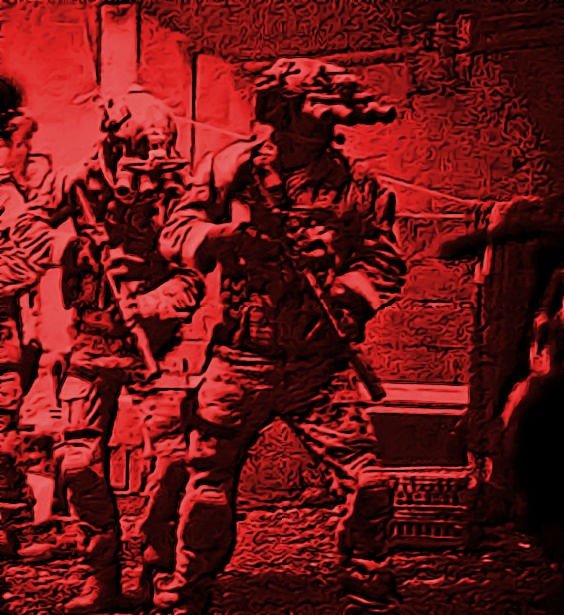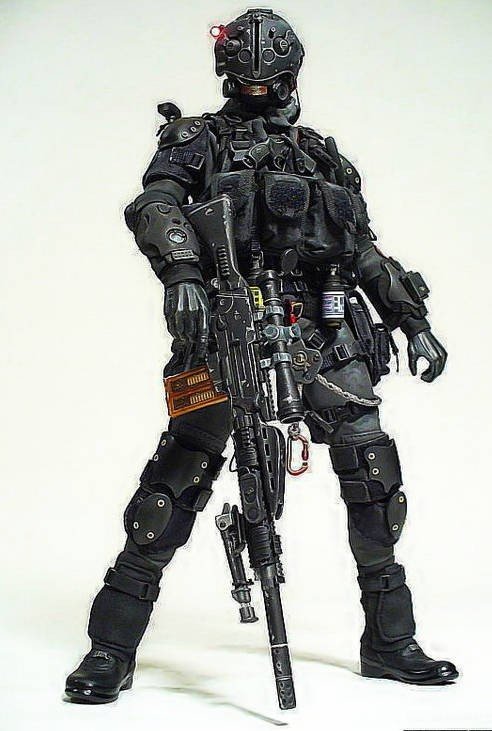Challenge30: No Easy Hero, No Easy Legend
I write stories. They tend to be about Hero's and Villains.
It's what people want to read.
A Hero on a Quest to get the Gold or win the Heart of a Fair Maiden.
Some of my stories involve Action Hero's .
My Action Hero's include "The SAS" (The Special Air Service) British Elite Special Forces.
A name made up to confuse the enemy back in the deserts of North Africa.

Image Courtesy by Business Insider
Much as the the USA Jet Fighter Pilots back in the Fifties all wanted to reach the highest peak.
The "Right Stuff," of Test Fighter Pilot, before the Space Program and being an Astronaut raised the bar.
Everybody soldier wanted to be in, "The SAS"
Then everthing changed.
In the Special Ops world, "SEAL Team 6" became the the highest bar to reach.
Or so it seemed. As we all looked in from the outside.
These were the Super Good Guys, Super Trained, Super Men. With Super Morals.
The Danish Army has it's own Special Ops guys called Jaeger Corps.
These guys went over and came out tops in a Big Fort Bragg Special-ops dick swinging contest.
After they came top, they explained it was because they were trained to think for themselves.
That shocked me for a while, as I thought these guys are the top of the top of the soldiering tree.
Jazus, they must all be able to think for themselves.
Surely it can't only be the Danish Army which is allowing these guys to think for themselves.

Image Courtesey of onesixthwarriors
And then it slowly struck me,"The SEALs," were just the same as everybody else.
Tougher yes, but not really any smarter.
They could Tab(Walk) further and had an ability to keep preforming day after day,
under intense pressure and could go literally an extra mile beyond what their body told them was possible.
But that did not make them perfect human beings.
They were still open to bribes,corruption and bare faced lies.
And could be, out thought by someone smarter, with the same training.
Which brings me back to the Jesse Ventura - Chris Kyle court case.
Where Kyle blatantly lied in his book about punching
Ventura in a SEAL bar in Coronado.
Ventura is not every bodies cup of tea.
He is a bit wacko and has extreme views on American Society.
But he was trained in the same environment as the Modern Seals and by all definition he was a SEAL.
Kyle was a genuine decorated SEAL War Hero from Iraq who lied unnecessarily about his Medals.
And some of the other stuff he had done when he came back from Iraq.
The Legend was beginning to crack.
So Kyle a Modern American SEAL Hero was telling lies.
Then we had the case of two SEAL 6 guys fighting over who actually shot Bin Laden.
I still love the legend of the Richard Marcinko created SEAL Team 6.
But as my Dad always said,
"When you have to chose between the Truth and the Legend, Stick with the Legend."
Which he got from the the Movie, "The Man who Shot Liberty Valance."
So for now I will stick with the Legend.
So here is the article that started my rant.
It is about the Darker Side of being a US NAVY SEAL TEAM 6 Operator.
Officially known as the Naval Special Warfare Development Group, SEAL Team 6 is today the most celebrated of the U.S. military’s special mission units. But hidden behind the heroic narratives is a darker, more troubling story of “revenge ops,” unjustified killings, mutilations, and other atrocities — a pattern of criminal violence that emerged soon after the Afghan war began and was tolerated and covered up by the command’s leadership.
THE WEDDING PARTY MASSACRE
ON THE AFTERNOON of March 6, 2002, Lt. Cmdr. Vic Hyder and more than two dozen operators from SEAL Team 6 boarded two Chinook helicopters en route to eastern Afghanistan hoping that within hours, they would kill or capture Osama bin Laden.
Earlier that evening, general officers from the Joint Special Operations Command had scrambled the SEALs after watching a Predator drone video feed of a man they suspected was bin Laden set off in a convoy of three or four vehicles in the Shah-i-Kot Valley, where al Qaeda forces had fortified themselves. Although the video had revealed no weapons, and the generals had only tenuous intelligence that the convoy was al Qaeda — just suspicions based on the color of the man’s flowing white garb and the deference others showed him — they were nervous that bin Laden might get away again, as he had a few months earlier after the bombing of the Tora Bora mountains in December 2001. This was a crucial moment: Kill bin Laden now and the war could be over after only six months. The vehicles were headed east toward the Pakistani border, as if they were trying to escape. The mission was code-named Objective Bull.
Afghanistan’s Paktia province is about the size of New Hampshire, with 10,000-foot ridgelines and arid valleys with dried riverbeds below, nestled along the border with Pakistan’s tribal areas. The prominent mountain range often served as the last geographic refuge for retreating forces entering Pakistan. As the special operations helicopters approached the convoy from the north and west, Air Force jets dropped two bombs, halting the vehicles and killing several people instantly.
That was not how the SEALs wanted the mission to develop. Inside the helicopters, some of the operators had pushed to hold off any air attack, arguing that they had plenty of time to intercept the convoy before it reached the Pakistani border. “The reason SEAL Team 6 exists is to avoid bombs and collateral damage,” said a retired SEAL Team 6 member who was on the mission. “We said, ‘Let us set down and take a look at the convoy to determine if it’s al Qaeda.’ Instead, they dropped several bombs.”
The bombing stopped the convoy along a dry wadi, or ravine, with two of the trucks approximately a kilometer apart. Survivors began to flee the wreckage, and over the radio, Hyder and his team heard the order that the convoy was now in a “free fire zone,” allowing the Chinooks’ gunners to fire at anyone deemed a threat, regardless of whether they were armed. The SEALs had no authority over the helicopter gunners.
The two Chinooks landed separately, one near each end of the convoy. Both teams exited the helicopters to find a grim scene. The SEALs with Hyder came out and separated into two groups. One, led by an enlisted operator, took in the damage to one of the vehicles. Men, women, and a small girl, motionless and in the fetal position, appeared dead. Inside the vehicle were one or two rifles, as is customary in Afghanistan, but none of the men wore military clothing or had any extra ammunition. “These were family weapons,” said the retired SEAL.
The SEALs from the other helicopter immediately headed up a steep hill after landing to locate an armed man who had been shot from the helicopter. When they reached the hilltop, the operators looked down in disbelief at women and children, along with the man — all were dead or mortally wounded from the spray of gunfire from the Chinook’s gunners, who had unloaded after the free fire zone had been declared. They realized the man had been trying to protect the women and children.
Other SEALs on the ground proceeded as though the survivors were combatants. Hyder and an enlisted operator named Monty Heath had gone in a different direction and saw a survivor flee the bombed vehicle toward a nearby berm. Heath fired once, hitting the man, sending him tumbling down the back side of the small rise.
At that point, Hyder began assessing the damage and surveying the dead. “I was going around to the different KIAs with my camera to take photos,” Hyder told me in an interview, using the military term for enemies killed in action. “It was a mess.”
Hyder said that he and a few other SEALs began to bury the casualties near a ravine by piling rocks over them. As he did so, he approached the man Heath had shot. “He was partially alive, faced down, his back to me, and he rolled over. I shot him, finished him. He was dying, but he rolled over and I didn’t know whether he was armed or not. That was the end of that.” Hyder said that his single shot had blasted open the man’s head.
According to Hyder, the encounter ended there. But the retired SEAL who was on the mission tells a different story. According to this source, after shooting the man, who turned out to be unarmed, Hyder proceeded to mutilate his body by stomping in his already damaged skull. When Heath, who witnessed Hyder’s actions, reported them to his team leader in the presence of other members of the team, “several of the guys turned and walked away,” said the retired SEAL. “They were disgusted.” He quoted Heath as saying, “I’m morally flexible but I can’t handle that.” Heath refused to comment for this article.
The retired SEAL, who spent the better part of two decades at the command, said he never asked Hyder why he mutilated the corpse. It wasn’t necessary. He assumed it was a twisted act of misplaced revenge over the previous days’ events — specifically, the gruesome death of Hyder’s teammate Neil Roberts.
Read the full Article :
https://theintercept.com/2017/01/10/the-crimes-of-seal-team-6
Challenge 30 is a 30 day writing challenge issued by @dragosroua to write and post every day in January.
60+ Badge Courtsey of @elyaque
100% Content Badge courtesy of @reneenouveau

